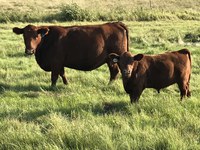Summer Pneumonia in Calves a Concern
(Click the image below to view a high-resolution image that can be downloaded)
Dead or sick calves are a scenario that is reported every year in a number of beef herds in the northern Plains.
“A list of all possible causes for this case can be very confusing to producers,” says Gerald Stokka, North Dakota State University Extension veterinarian and livestock stewardship specialist. “However, depressed, feverish calves with an increased respiratory rate most likely will fit the diagnosis of ‘summer pneumonia.’”
The common question generated by this diagnosis is: Why would nursing beef calves in the pasture with little stress in their lives come down with respiratory disease or pneumonia?
What is Summer Pneumonia?
Summer pneumonia is respiratory disease/pneumonia that occurs in beef calves nursing their dams. The age range of calves affected can be as early as 3 to 4 weeks and from 3 to 5 months of age.
Calves are born with little to no immunity and are dependent on receiving a passive transfer of immunity from their dam through colostrum. This passively acquired immunity declines through time, and unless the calf develops active immunity through vaccination or exposure to infectious agents, they eventually will become susceptible to pathogens that can cause respiratory disease.
“This is why some calves are susceptible at a very young age (3 to 4 weeks) and other calves become susceptible later,” Stokka says.
Conditions Leading to Summer Pneumonia
Stressful conditions that may precipitate an outbreak of summer pneumonia in nursing calves:
- Certain weather events can increase the risk of developing summer pneumonia. For example, mid to late spring blizzards or rain can deprive the calf of normal nursing patterns and produce hypothermia/chilling in calves. Late spring or summer high temperatures can produce heat stress in cows and calves, resulting in greater susceptibility to infectious agents. Also, dry, dusty conditions can increase susceptibility because the calves’ normal innate, clearing defense mechanisms can be overwhelmed, which allows for pathogens to proliferate and gain access to the lungs of young calves.
- Mixing groups together after calving, such as moving cow-calf pairs to pasture or mixing groups together for heat synchronization and artificial insemination procedures, can result in cattle re-establishing their social order and allowing the transmission of infectious agents.
- When calves are sorted for moving or synchronization programs, they can have separation anxiety and nurse infrequently, which increases stress.
These organisms are commonly found in summer pneumonia cases:
- Bacterial organisms, which include Mannheimia hemolytica, Pasteurella multocida and Histophilus somni
- Viral agents including BRSV (bovine respiratory syncytial virus), BRCV (bovine respiratory coronavirus), IBR (infectious bovine rhinotracheitis) and BVDV (bovine viral diarrhea virus)
“Vaccination can be effective in reducing the risk of summer pneumonia when caused by agents for which a vaccine is available,” Stokka says. “However, vaccination in young calves does not equate with a 100% response rate. Nor does it reduce the stress associated with weather, dry, dusty conditions, sorting and mixing. In addition, while some pathogens may have commercially available vaccines, information to evaluate effectiveness is limited.”
NDSU Agriculture Communication - May 11, 2021
Source: Gerald Stokka, 701-231-5082, gerald.stokka@ndsu.edu
Editor: Ellen Crawford, 701-231-5391, ellen.crawford@ndsu.edu


